Leaves and Nutrient Deficiencies
When it comes to tomato plant leaves and nutrient deficiencies, they say that tomato growers with poor eyesight are the happiest because they can’t see the various spots and markings that appear on their tomato plant leaves each season.
it is very common for plants to show all sorts of deficiencies on their leaves, especially at this time of the season – you may have some strange looking markings on your plants too!
Phosphorus, potassium or magnesium deficient are very common – especially on the lower leaves.
Here are some examples on my plants – from previous seasons.
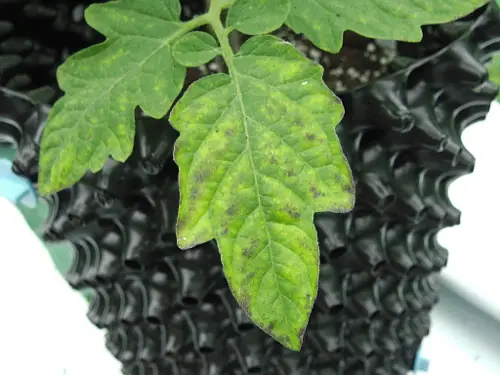
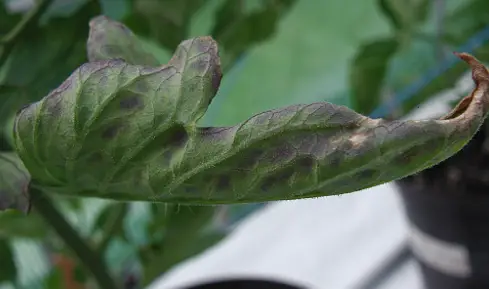
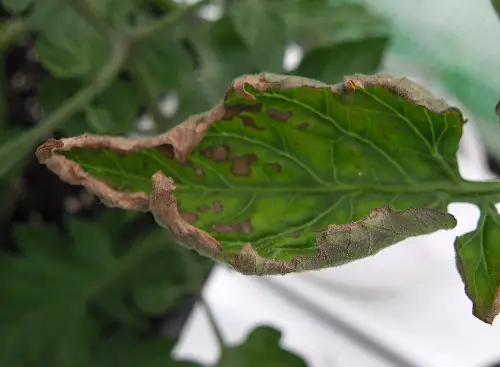
Tomato Plant Leaves and Nutrient Deficiencies
Some leaves may be affected by all three mineral deficiencies at the same time!
To make it even more difficult to diagnose, some varieties display these deficiencies in slightly different ways. That’s one reason why professional growers will get to know a variety over several growing seasons and be able to get the very best results from a variety.
For example, I know Red Alert very well, but when it comes to some of the new varieties, there is some trial and error involved.
More photos of nutrient deficient leaves
So what can you do when your plants leaves show nutrient deficiency? The answer is … not very much!
It’s often the case that the deficiencies were caused by temperature variations (poor weather) when the affected leaves were forming.
Or, the nutrients have been taken from the lower leaves and used by the upper leaves … the growing tip always gets preference over lower leaves and takes the minerals that are stored in them. (aka translocation).
Lower leaves often turn a pale green or yellow colour because nitrogen and magnesium have been removed to the growing tip.
What to do
Remove affected lower leaf branches that are losing their colour or yellowing- it’s the new growth that matters and it’s quite likely that the leaves at the top of the plant will look very healthy.
Magnesium – Foliar Spray Benefits
One way to get plants to grow faster (and healthier) is to increase their rate of photosynthesis.
This may be done by making sure that leaves are a dark green colour – the darker the colour, the more light is absorbed, and therefore, the process of photosynthesis works better. To absorb more light is helpful when light levels are low in a poor summer.
How to get dark green leaves
Magnesium is used in the process of making chlorophyll (the green pigment in leaves) and so a foliar spray of magnesium will help “green-up” leaves and make them a darker colour – they will attract more light.
Also, magnesium is needed by tomato plants in larger amounts around the early summer, so a foliar spray with magnesium is useful for this reason too.
Double Stem Technique
Double Stems and Side Shoots
Some tomato growers will allow a side shoot to develop and become a second main stem.
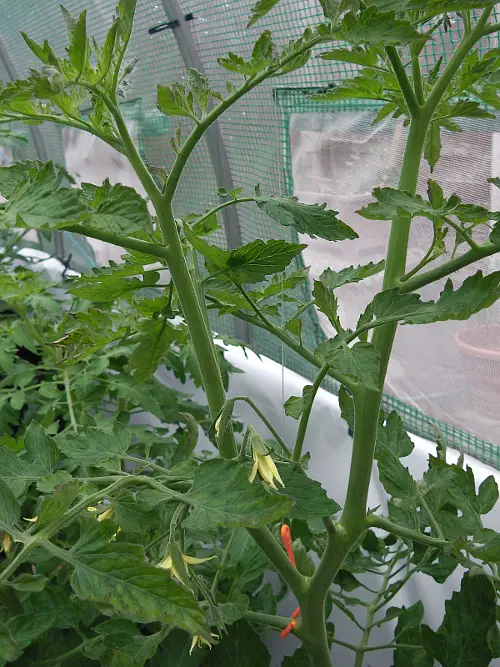
This is known as the “double stemming technique” and will provide more trusses before the plant grows out of the greenhouse roof!
That’s assuming we have a good enough Summer and time enough to grow more tomatoes from one plant before the Autumn weather begins.
It’s best to use this technique with cherry varieties that are quick to mature if you are in the UK – and especially if growing outdoors.
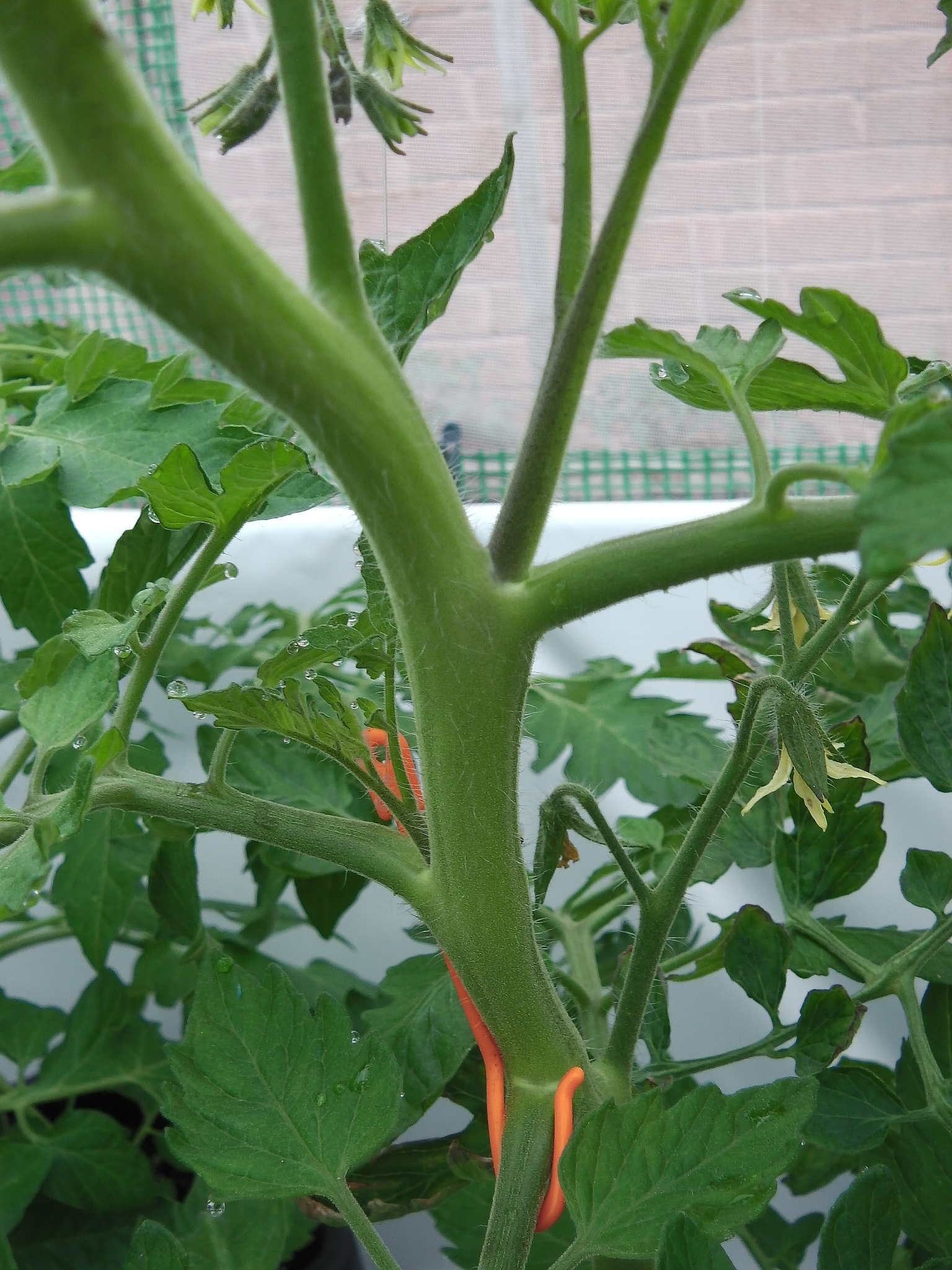
This side shoot could be left to grow and create a second stem if required … otherwise, it’s best removed.
Some gardeners who live in areas of the world that have longer seasons than in the UK, don’t remove side shoots on their tall varieties. This means they may have at least six or seven main stems!
In a long season of good weather, a tomato plant will perform and produce a fabulous crop – In the UK, it will probably run out of steam and produce smaller trusses than normal.
That’s it for this week – don’t look too closely at those leaves!
Regards,
Nick

Chris
Always interesting and valuable Nick. Re magnesium deficiency…epsom salts?
A dilute milk spray to help combat possible calcium deficiency too?
Nick
Hi Chris – you took the words right out of my mouth!
You could also use Chempak Magnesium and Chempak Calcium.
andy
hi Nick,great newsletter this week,as always.Just wondered if yourself or any readers have grown or are growing the Polish variety of tomato called Betalux?.tried 3 plants last season and they did realy well,no blight,BER etc and produced plenty and very tasty fruits.I have always grown using the good old ring culture method like my father.Last year i purchased the quadgrow planter and used the nutrigrow feed as recommended to use with it.fantastic results.so much so that this year i have made my own type of quadgrow system to trial.It’s made up of asda flower buckets,(free of charge as stepson is a manager at our local store) capillary matting and plastic waste pipe.too early to give a yea or nay at the moment.I have got a few large Marmande type that i grow each year,from seeds bought back from a holiday in Crete that do well if only allow 4 to 5 fruits to grow and de-flower to let them mature.
Nick
Hi Andy, I haven’t tried Betalux although I have tried a couple of other Polish varieties.
The Quadgrow gives excellent results with its reservoir system – if you have a lot of plants, the Autopot system is very effective too.
Michael Johnson - Nottingham UK.
Hi-Nick, and friends, the latest tomato craze for growing monster plants in the USA, is sow the seeds in fine grade Diatomaceous Earth D.E. for short, and grow them on in larger granules of D.E. of 3 6 mm in size, the end result is enormous plants with massive root balls, the root balls are 3-4 times bigger than normal, D.E. is readily available on e-bay, one of the best places that I have found is http://www.multi-mite.co.uk who stock all the products requires, the large grade stuff is called the best slug& snail killer, and the finer grade stuff is called mutimite, because it is primarily used to kill every form of insects and mites, red spider mites, white flies etc, just by dusting the powder on them, and is totally none poisonous and can be fed to all animals and birds including humans, I don’t think it has ever been used to grow plants in or to start off seed to germinate in etc, in the U.K.before, however there are dozens of videos on (youtube) about growing seeds in it and growing giant plants with it, so it might be worth a look on there for further info, I have ordered 20 kg of the course grade and 2kg of the fine grade from them and are using it already, I was so impressed by the results, you have to feed the stuff of course with normal liquid tomato feed in order to get those massive root balls and possbly 8 to 10 foot multi truss tomato plants with it.
Nick
Thanks Michael for the information – very interesting!
Rhys Jaggar
One benefit of removing lower leaves at this time of year is that the plants respond by making more trusses and starting to flower quite rapidly.
I gave my plants their annual ‘spring shear’ on 31st May and apart from decluttering the lower areas, I now have many trusses and in several cases flowers on the third truss.
As I grow out of doors in pots, the more flowering trusses I can create by July 10th, the better.
So far this year, the Gods have been smiling on NW London. Great second half of May as the plants moved outside for good and June has started with good temperatures for fruit set. The leaves are mostly all dark green as Nick describes. The next six weeks will decide whether the potential for a great season will be realised or not…..
Nick
Hi Rhys,
It’s good to hear that your plants are doing so well – some of my indoor plants have had problems with fruit set owing to the high temperatures they experienced recently. Growing outdoors has its advantages!
Rhys Jaggar
Swings and roundabouts Nick!
Next three or four days is too cool for rapid progress outside, so your indoor ones will be catching up. Then it seems that it will be warm again up here, so mine will accelerate again and you will have indoor challenges….
Usually you will get higher yields indoors than out…..
Jess Allaway
Hi Nick,
I am sure you probably mentioned this in the past but the memory gets worse every year! One of my full size fruit tomato plants (I only have four of those) has suddenly developed long thin leaves. Any treatment for that or should I get rid of it? We did have very high temperatures for a couple of weeks. Don’t know if that was responsible, but all other plants seem OK. Will move it in the meantime so it doesn’t touch another plant. Any advice much appreciated.
Best regards,
Jess.
Nick
Hi Jess,
I find that when temperatures and light levels are high, some varieties grow thinner leaves than usual. It’s as if they don’t require as much light as they are getting so reduce width of leaf size – this also reduces the amount of moisture a plant loses through its leaves.
This is more of an educated guess than firm fact!
You may find that new leaf growth eventually returns to normal.
Kind regards,
Nick
Richard
Thanks. Your report this week on purple leaves had answered my question before I sent it. Thanks for the information.
Nick
I’m pleased you found the newsletter helpful!